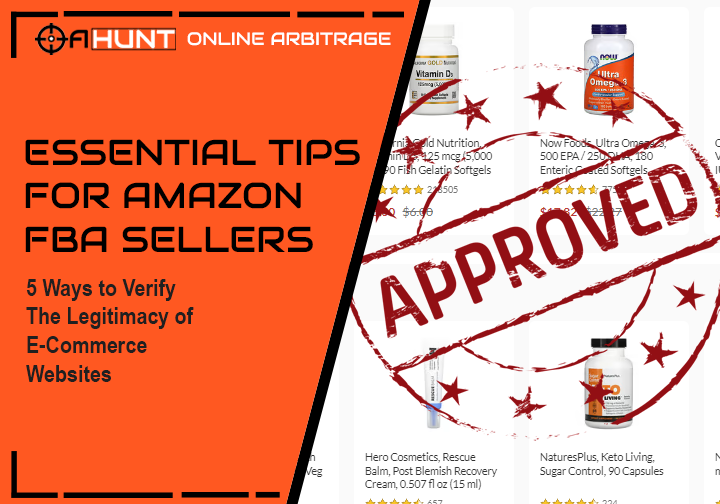Product Lists
A great tool to use for getting winning amazon products is to sign up for a Leads List. A leads list or Product List is a list of potential winning products and where to source them. This takes a lot of the guesswork out of Online Arbitrage.
There are a lot of different product lists to choose from out there. Each list owner presents the information to you in different ways. I have used a lot of Amazon FBA Lead Lists and the one mistake I see people making over and over is improper product analysis. Just because you are given a list or even given a tip on a great product does not mean you should buy it without doing a bit more research. Below I will lay out how I approach FBA product analysis to ensure I am always buying a product that will sell.
Tools you will need
It’s not enough to just have a list of potential products handed to you and you start buying based on what is on the list. This is a recipe for disaster! Yet I see it every day. Things move pretty fast on amazon. This means the price can change, the number of competitive sellers, and even your ability to sell it can change. So you MUST do your homework first before buying any product. There are a few tools that I highly recommend you add to your arsenal that will make your life a lot easier. I have listed them below and we will dive deeper into these tools throughout this article.
- Product Selection Criteria
- Sales Volume
- Keepa
- AZ Insight
- ASIN Gadget
- Rakuten
Every amazon seller has their perfect toolbag set up with all the things they need to analyze any product. This is mine. As you dive into this and start analyzing products you will find your way and your tools. That is a good thing! It means you are creating your way based on the accumulated knowledge of what works and what doesn’t.
Product Selection Criteria
One of the first things you will need is guidelines around what you want to see in a product. This will include:
- What ROI are you looking for?
- What is your minimum profit per product?
- How many sales per month do you prefer?
- How many competitive sellers are you comfortable with?
- Are you ok with Amazon on the listing?
I keep a checklist that I mark off every time I am analyzing a product. In the beginning, this checklist was an actual checklist. The more I did this the easier it became and now I keep this checklist in my head.
ROI - Return On Investment
ROI is a simple term that means, how much profit do you want to make per sale. It is generally expressed as a percentage. I would say the most common percentage I see is between 15% - 60%. You can def go much higher though! But it’s less common in Online Arbitrage.
Example: Let’s say you buy a product for $8 and you are going to sell it for $25. To find out the ROI of this product based on the initial investment you need to know how much your profit will be. We will cover how to find the profit of each product later, for now, let’s just say your profit will be $3. So to get your ROI, you will divide 3 from 8. This will give you .37 or 37%. So for this product, your ROI is going to be 37%. Don’t worry, there are tools we will go over later that do all this for you.
This is a SIMPLE example that does not take into account Amazon fees, Shipping, Taxes, etc. But we will get into all that later in this article.
I track my ROI daily. This is one of the most important parts of my product selection because it is how I scale my business faster.
If you have an average ROI of 50% and you are spending $1,000 per month on products, this means you are profiting $500 per month. This allows you to roll that $500 into the next month and scale. If your average ROI is 15% and you are spending $1,000 per month on products, then you are profiting $150 per month.
You may be asking yourself, Why on earth would anyone go with 15% ROI?? That’s a valid question. The answer is sales volume. If the 15% ROI product has extremely high sales volume and the 50% ROI product has very low sales volume, you can profit more with the lower ROI product.
Sales Volume
Sales volume does go hand in hand with ROI and should be the second piece you look at when you are determining whether or not to purchase a specific product.
There are 3 different ways to find sales volume. I’m sure there are more than that but these are the most common methods I see.
Free Option - If you arent using a Lead List that shows you the sales volume, you can go to Jungle Scouts Amazon Sales Estimator and type in the BSR, Marketplace, and Amazon Product Category and it will give you a rough estimate of sales.
Somewhat Free Option - If you are a part of an OA Lead List, they will generally provide you with the sales volume for each product. You still want to double-check this volume because it can change at any time.
Paid Option - The next two tools you can use to find sales volume is Keepa and AZ Insight. I feel you need both of these tools when analyzing products. Keepa can give you a good idea of sales volume but AZInsight will give you a more accurate number.
Minimum Profit Per Product (PPP)
The minimum profit per product is similar to ROI but I view it as a standalone selection criterion.
The minimum profit per product is simple, how much do you want to make per product in profit? The answer is never simple though.
You can have an ROI that is 200% but the PPP might be $2. For me, my minimum PPP is $3.50.
How Many Is Too Many?
When it comes to competition, this is something to dig into but also project for. The formula you use here is simple. Divide the number of competitive sellers by the number of sales per month, make sure to include yourself as a competitive seller, and this will give you how many sales you should project for each month.
Example: You found a great product, good volume, and the ROI and PPP are where you want them. Now it’s time to ensure the competition isn’t too high. For this, you do a quick calculation. Let’s say there are 12 competitors and 243 sales per month. I want to add one additional competitor so I include myself and I divide 243 by 13. This would give me 18 total sales per month. Now if there are 12 competitors and 26 sales per month, I would get 2 sales per month.
I prefer at least 10 sales per month. This isn’t 10 total for everyone, this is 10 total for me. Anything less and I generally skip the product. I will make an exception if the ROI and PPP are high enough though. You need to find what you’re comfortable with.
Amazon On The Listing
This is a heavily debated topic. Do you buy a product and list it if Amazon is also on the listing. I have heard every argument for this and I understand both sides. I don’t go for a product if Amazon is listed as a seller on it. I know a lot of people that do though. My suggestion, if you want to give this a shot go for it! But test it. Always be testing. Purchase a small amount of the product, list it and see how it sells.
One thing you will find out as you move through this, there isn’t just one factor that will help you determine what product is good or bad. It’s multiple. They all play together and need to be viewed as a whole. You can have a product that makes 200% ROI and $20 PPP but there might also be 20 FBA sellers and only 10 sales per month. The ROI and PPP are great but it’s still not a good product to buy.
I put together a sample checklist you can use. This is just a sample that will give you a visual starting point to help you as you build out new processes and find out what works best for your business.
Keepa
If you’ve been doing Retail Arbitrage, Online Arbitrage, or anything in between for more than 5 minutes, then you have probably heard of keepa. To me, Keepa is a MUST have. Not just for the sales graph. The sales graph is amazing and insanely helpful. But also for the data it gives you on variations.
One of the hardest parts, in my opinion, of Online Arbitrage, is when you come across a product that has multiple variations. This can be tough! A common blunder I see on most lead lists is they do not take into account the variations.
When you view sales projections on a product, many times you are viewing the sales projection for all variations as well. So it might look like a great buy, the variation you are looking at might not sell well.
Here is a trick I use to figure out if the variation is worth going after.
- Scroll down to the keepa chart at the bottom of the product
- Select the “Variations” tab
- Click on the ‘Ratings’ column twice
- This sorts from most to least ratings
- Find the product variation you are looking at selling
- Ensure the volume of ratings is in the majority
- If it shows a low volume of ratings, this can mean that the variation you are looking into does not sell very often.
AZ - Insight
AZInisght is a very popular Chrome extension that gives you a TON of information about the potential product you are looking for. Some of the insights it gives are:
- FBA/FBM breakdown of Pricing, Profit, ROI, and Margin
- BSR Ranking
- Estimated Sales
- Estimated Monthly Revenue
- Breakeven Price
- Product Weight
- Product Dimensions
- FBA sellers
- FBA Competitive offers
- Ungated Notification
- Hazmat Notification
- Meltable ASIN Notification
- IP Complaint Viewer
Almost everything is customizable for your specific criteria.
One of my favorite features is the custom Cost Calculator. I use a prep center, for every product I buy, I need to take into account the cost for the prep center. I have two different costs. One for individual products and one for bundles. The custom cost calculator allows me to easily select these options within the calculator and see how it impacts my ROI.
It’s very easy to set up too!
- Once you have AZInsight installed into your browser, navigate to the upper right-hand corner and click on the gear icon
- From there go down to ‘Manage Custom Costs’
- Click the ‘Click to open Custom Cost Viewer
- Add in any additional costs you want to account for
Chrome Extensions
I use 4 chrome extensions (Besides AZInsight) regularly.
- RevROI - Most of you have probably heard of Rakuten, Topcashback, Raise gift cards, etc… but have you heard about RevROI? It’s a cashback/gift card/airline miles extension that is a no-brainer to install. It tells you the best money saving addons out there and does it in seconds!
- IP Alert - This chrome extension is worth its weight in gold! For those that don’t know, an IP (Intellectual Property) claim is when a brand owner files an IP claim for a specific ASIN. They allege other sellers on the Amazon listing are unlawfully using their Intellectual Property. If you get too many of these, Amazon can close your account for good. This chrome extension will tell you if there have been any IP complaints on a product you are viewing.
- ASIN Gadget - A light and super useful extension that will give you easy to identify indicators on the Amazon product page. It will tell you whether you're restricted to sell that product, if it's considered hazardous, and if it's considered meltable. You can get the basic for a great price and it's a lifetime license, or upgrade to the pro version for an annual cost (the perks are well worth it)
The Data-Driven Approach
As you can see from what we have gone over, there are a lot of factors that need to be taken into account before purchasing any product. It doesn’t matter who is giving you the information or lead, do your homework! It’s your business, the more serious you take it the more successful you will be.
Once you have your Product Selection Criteria setup, stick to it. So many people get in trouble financially because they make emotional decisions when it comes to purchasing products. You need to remove emotion and allow the data to speak to you. If you make your decisions based on data, you will have a lot more success with the products you purchase!





17 Jul
Robert
Very helpful, however I don't see some of the screenshots like the sample checklist you mentioned and Keepa variation.
Reply06 Feb
derek
Thanks Robert. We'll get those screenshots fixed.
07 Aug
Geri Chua
Agree with Robert. Very helpful. Thank you. I too only see broken image links. Would love to see the screenshots when its fixed.
Reply19 Jan
Vlad Denko
Great article! Thank you for your time writing it.
Reply28 Mar
big Tim
Awesome information
Reply